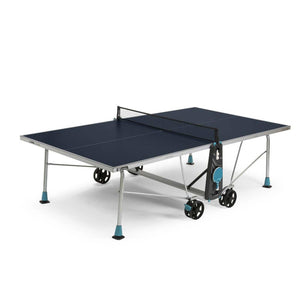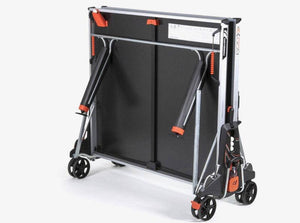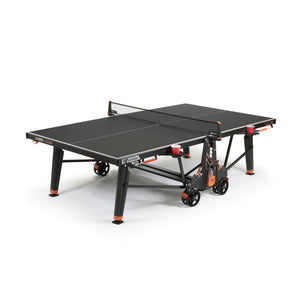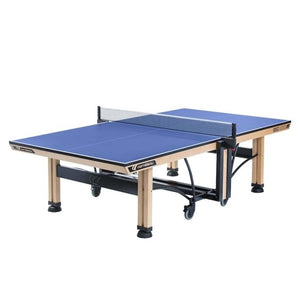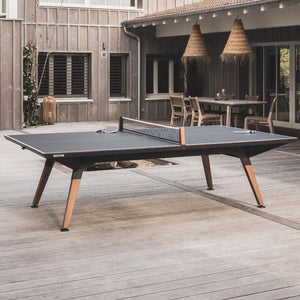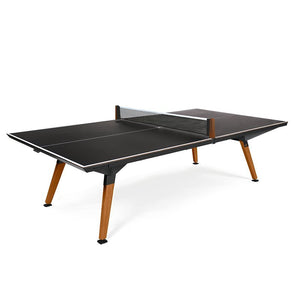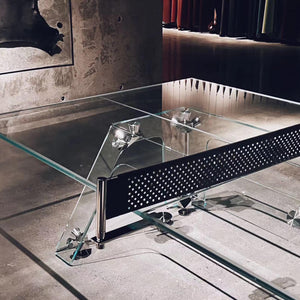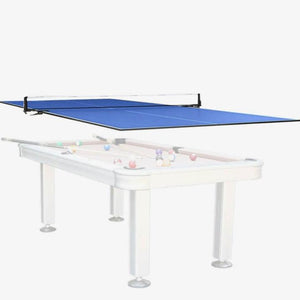Table Tennis Table Buyer's Guide (Part 1)

Table Tennis is easy to play, doesn't require much equipment, and easily folds to fit small spaces. Little wonder that the game of ping pong is extremely popular all over the world today, evolving from Victorian times into the modern game.
While most tables look similar in size and appearance - the standard table tennis table size comprises a 9ft x 5ft playing surface - important variations between different tables nonetheless exist. These include:
- Material and Thickness of Table surface
- Frame Material and Stability
- Mobility and Safety
- Other features
In Part 1 of this two-part series, we share the major factors that can influence the type of ping pong table purchased, be it game room, man cave, office or bar.
Table Tennis Tables: 4 Key Considerations
1. Table Material and Thickness
Medium-Density Fiberboard (or MDF) are used in table tennis tables within indoor, climate-controlled environments and for competitions. Also known as chipboards, they typically come in between 11 - 22mm, though the best ones go up to 19 - 25mm. As the thickness of a play surface directly influences the height (and therefore quality) of the rebound, the general principle is that the thicker the tabletop, the better.
Laminate resin on the other hand, is weather-proof and typically used for outdoor tables. Resistant to warping and moisture, they ensure consistent bounce under different weather conditions. Unlike chipboards, laminates employ a different thickness scale and are typically between 3 - 7mm. The top outdoor tables are constructed with laminates as thick as 8mm, offering rebound quality comparable to that of a competition table.
To summarise, here's a quick video of how indoor and outdoor table tennis tables differ.
We Recommend: Knowing your play purpose is key. The first question you'd want to ask when buying a table tennis table is "Where will I be playing?", because indoor and outdoor tables correspond to very different design philosophies.
The second question would be about "how competitive is my play?". The more competitive your game is, the thicker (and therefore higher performance) the playing surface required.
While indoor tables are usually used for competition, top-end outdoor tables combine thick performance-level surfaces with weather-resistant qualities, making them perfect for competitive play both indoor and outdoors.

2. Frame Material and Stability
The playing surface sits on a frame, which varies in thickness from 35mm to 80mm. The thicker the frame, the more strength and stability conferred. A sturdy frame allows the surface to remain perfectly flat over time, especially when paired with a thick playing top.
In addition, a frame manufactured from metals such as alloy, zinc and aluminium offers corrosion-resistance, enhancing the longevity of the table.
However, strength is not the only consideration. For example, while steel frame tables are sturdy and durable, offering stability for heavy use, they might be too heavy to move around. Aluminum frames are light, strong, and portable, and hence are used more in recreational tables.
We Recommend: If you plan to play outdoors, getting an alloy frame confers benefits combining strength, portability and durability. Cornilleau Tables, for example, come equipped with frames manufactured from steel alloy, zinc and aluminium for the best in corrosion resistance.

3. Mobility and Safety
Regardless of play surface or frame, all good tables require safety and mobilty features such as i) locking points, ii) wheel and wheel brakes, and iii) leg levellers.
- The more locking points on a table, the greater each joint is well-fastened for stability, be it during play or in a closed storage position which prevents it from crashing down. 8 locking points is the minimum standard you should ensure for your table, although Cornilleau Table Tennis Tables go way beyond with 16 locking points - talk about safety standards!
- Wheels should be of high-quality material and construction to protect against wear and tear, as well as easy movement. You should ensure they come with secure brakes that help the table stay fixed during play or storage.
- Leg leveller assembly determines the stability of the table so broader legs are more stable. Some tables are supplied with leg levellers which allow you to easily adjust it for uneven ground as well as wheelchair play.
We Recommend: Always insist on adequate locking points, a good set of wheels and brakes, and leg levellers to ensure safe and stable play. For best stability, opt for larger wheels that offer unrivaled maneuverability, adjustable levelers to compensate for uneven floors.

4. Other Features
It's worth considering other add-on features that may seem like extras but go a long way to offer top-notch play experience.
- Anti-Glare Properties: Some outdoor table surfaces are enhanced with anti-glare coating (some even up to 10x!) to make sure players aren't blinded by the sun’s rays.
- Protective corners equipped on the table edges help prevent you from accidentally hitting your hips on a ping pong table, especially during a turn.
- Feet and Net Adjustments: For greater precision, some models have built-in adjustments to net tension and/or height, as well as feet dials to save you the trouble of lifting the legs to configure the table height.
- Storage: Besides containers to hold rackets and balls and a drink (important!), some tables also offer quick retrieve ball dispensers to ensure you always have a ball in hand.
- Dining table tops: Increasingly popular, convertible Table Tennis Tables come with table tops that allow it to transform into a dining table for post-meal entertainment.
We Recommend: A host of features are available for greater ergonomics, safety and multi-functionality, which influence the price of the table. Given the slew of options, choose features that suit your play to find the best table for your budget.

Warranty: A Side Note
Given their volume and cost, table tennis tables are not intended to be replaced frequently. While it's hard to prove long term durability besides the test of time, the extent of warranties offer an insight as to reliability.
All Cornilleau outdoor tables possess a (pretty much unheard of) 10-year guarantee on tops and components except wearing parts (wheels, net and net posts) as standard, and any manufacturing defect for a period of 3 years.
In Summary
By simply asking yourself the right questions, choosing a table tennis table is easier than you think. Factors to consider include the following: i) material and thickness of the table surface, ii) the supporting frame, iii) stability and safety mechanisms, as well as iv) other features.
Now that you're aware of the basic factors affecting table tennis tables, stay tuned to learn more about in Part 2 of this guide where we discuss in-depth some of the table tennis features that distinguish tables that offer you a great playing experience from merely a good one.




